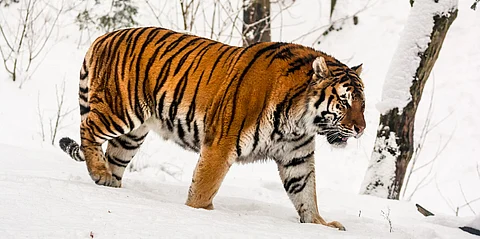

The Amur or Siberian tiger (Panthera tigris altaica) is becoming roadkill in the taiga of the Russian Far East, something which could threaten its long-term survival in the region, a new study has warned.
Between 1980 and 2023, there were 26 collision incidents involving the tigers, the largest cats on earth. Twenty-two of them occurred on roads and four on rail tracks.
“From 1980 onwards there were 3-4 incidents in each decade but with a marked increase during 2020-2023 (46% of the total). The highest mortality was in winter, with 19 of the 26 cases (73%), 10 of which were in January. The remaining seven cases were during April-October when mean temperatures are > 0 °C. The time of day was recorded for nine of the incidents, all of which were at twilight or at night. The four incidents on railways were all in the winter (January-March), and all during 2017-2023. Fourteen of the incidents involved adult tigers, seven involved subdadults and five involved cubs < 6 months old. Of the 20 tigers for which sex was known, 11 were male and nine female,” the paper noted.
The findings are grim in the light of the fact that the Russian Far East is the last stronghold of the Amur tiger, which suffered a catastrophic decline in numbers during the 1930s-1940s as a result of uncontrolled hunting and trapping for zoos, leaving only 40-50 individuals remaining.
While the population has stabilised since then to 300-350 adults, the tiger is still categorised as ‘Endangered’ on the International Union for Conservation of Nature Red List.
While poaching and illegal wildlife trade are the most immediate threats to the Amur tiger, the paper describes in detail, the detrimental impact of roads on the magnificent cats.
Roads are continuing to expand into the Amur tiger’s range in the Russian Far East. The total length of roads in Primorsky Krai and Khabarovsky Krai is 28,000 km, including over 4,000 km of paved roads, as per the researchers.
“The number of vehicles, the intensity of road traffic and the speed of movement along roads are all increasing…A significant part of the expansion of the road network in the Sikhote-Alin Mountains is in remote areas, where many roads are constructed for logging, without any environmental impact assessment,” the paper noted.
Roads give poachers access to remote forest regions. They also fragment protected areas by limiting animal dispersal and gene flow.
But the main damage is caused by roadkill or the deaths of animals after colliding with vehicles. “On secondary roads there are no wildlife crossings or barriers to prevent tigers accessing the road, and on paved highways there is only one wildlife tunnel, in the Khasansky District of Primorsky Krai (the Narvinsky tunnel),” noted the study.
The researchers also found that the reason behind the rise in tiger fatalities in traffic incidents during 2020-2023 coincided with an epidemic of African swine fever in wild boar populations in the region, the tiger’s main prey.
As their natural prey declined, the tigers frequently ventured “into anthropogenic landscapes in the Amur and Ussuri valleys, where the main highways and railways of the region are located”.
More tigers died due to collisions in winter because many of their prey animals like the Asiatic badger , raccoon dog , Asiatic black bear and brown bear hibernated.
“Secondly, ungulates born in the spring are larger by winter and thus less vulnerable to predation. As a consequence, tigers must travel longer distances in search of food, often approaching settlements and roads, and they may utilize the road network because of the deep snow cover elsewhere. This period is also when the majority of conflicts occur between people and tigers. Thirdly, snow and ice on roads increase vehicle braking distances and thus the probability of a tiger dying as a result of a collision,” the researchers inferred.
They concluded that wildlife-friendly road design, including crossings, tunnels and fences, is essential for reducing tiger mortality, especially near protected areas. “Addressing road traffic incidents through strict traffic law enforcement, improved road planning, and habitat protection is crucial for ensuring the long-term survival of the Amur tiger in the Russian Far East,” according to the scientists.
Tigers on thin ice: traffic mortality incidents and Amur tiger conservation in the Russian Far East has been published in the journal Oryx on March 20, 2025.The authors are Aleksey Yurievich Oleynikov, Sergey A. Kolchin and Galina P. Salkina.